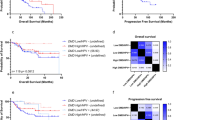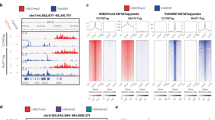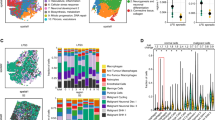Abstract
Mesomelic dysplasia Kantaputra type (MDK) is characterized by marked mesomelic shortening of the upper and lower limbs originally described in a Thai family. To identify the cause of MDK, we performed array CGH and identified two microduplications on chromosome 2 (2q31.1-q31.2) encompassing ∼481 and 507 kb, separated by a segment of normal copy number. The more centromeric duplication encompasses the entire HOXD cluster, as well as the neighboring genes EVX2 and MTX2. The breakpoints of the duplication localize to the same region as the previously identified inversion of the mouse mutant ulnaless (Ul), which has a similar phenotype as MDK. We propose that MDK is caused by duplications that modify the topography of the locus and as such result in deregulation of HOXD gene expression.
Similar content being viewed by others
Log in or create a free account to read this content
Gain free access to this article, as well as selected content from this journal and more on nature.com
or
References
Kantaputra PN, Gorlin RJ, Langer Jr LO : Dominant mesomelic dysplasia, ankle, carpal, and tarsal synostosis type: a new autosomal dominant bone disorder. Am J Med Genet 1992; 44: 730–737.
Kantaputra PN : Thirteen-year-follow up report on mesomelic dysplasia, Kantaputra type (MDK), and comments on the paper of the second reported family of MDK by Shears et al. Am J Med Genet A 2004; 128A: 1–5.
Shears DJ, Offiah A, Rutland P, Sirimanna T, Bitner-Glindzicz M, Hall C : Kantaputra mesomelic dysplasia: a second reported family. Am J Med Genet A 2004; 128A: 6–11.
Kwee ML, van de Sluijs JA, van Vugt JM, Wijnaendts LC, Gille JJ : Mesomelic dysplasia, Kantaputra type: clinical report, prenatal diagnosis, no evidence for SHOX deletion/mutation. Am J Med Genet A 2004; 128A: 404–409.
Ventruto V, Festa B, Renda S et al: [Phenotype anomalies in subjects with balanced chromosome translocation. Presentation of 4 cases]. Pathologica 1983; 75 (Suppl): 258–261.
Sugawara H, Egashira M, Harada N et al: Breakpoint analysis of a familial balanced translocation t(2;8)(q31;p21) associated with mesomelic dysplasia. J Med Genet 2002; 39: E34.
Fujimoto M, Kantaputra PN, Ikegawa S et al: The gene for mesomelic dysplasia Kantaputra type is mapped to chromosome 2q24-q32. J Hum Genet 1998; 43: 32–36.
Klopocki E, Schulze H, Strauss G et al: Complex inheritance pattern resembling autosomal recessive inheritance involving a microdeletion in thrombocytopenia-absent radius syndrome. Am J Hum Genet 2007; 80: 232–240.
Klopocki E, Ott CE, Benatar N, Ullmann R, Mundlos S, Lehmann K : A microduplication of the long range SHH limb regulator (ZRS) is associated with triphalangeal thumb-polysyndactyly syndrome. J Med Genet 2008; 45: 370–375.
Dathe K, Kjaer KW, Brehm A et al: Duplications involving a conserved regulatory element downstream of BMP2 are associated with brachydydactyly type A2. Am J Hum Genet 2009; 84: 483–492.
Kim JI, Ju YS, Park H et al: A highly annotated whole-genome sequence of a Korean individual. Nature 2009; 460: 1011–1015.
Zakany J, Duboule D : The role of Hox genes during vertebrate limb development. Curr Opin Genet Dev 2007; 17: 359–366.
Goodman FR : Limb malformations and the human HOX genes. Am J Med Genet 2002; 112: 256–265.
Prieur M, Lapierre J, Le Lorch M et al: HOXD gene cluster haploinsufficiency does not generate gross limb abnormalities. Eur J Hum Genet 2000; 8 (Suppl. 1): 74.
Slavotinek A, Schwarz C, Getty JF, Stecko O, Goodman F, Kingston H : Two cases with interstitial deletions of chromosome 2 and sex reversal in one. Am J Med Genet 1999; 86: 75–81.
Dlugaszewska B, Silahtaroglu A, Menzel C et al: Breakpoints around the HOXD cluster result in various limb malformations. J Med Genet 2006; 43: 111–118.
Spitz F, Montavon T, Monso-Hinard C et al: A t(2;8) balanced translocation with breakpoints near the human HOXD complex causes mesomelic dysplasia and vertebral defects. Genomics 2002; 79: 493–498.
Spitz F, Gonzalez F, Duboule D : A global control region defines a chromosomal regulatory landscape containing the HoxD cluster. Cell 2003; 113: 405–417.
Herault Y, Hraba-Renevey S, van der Hoeven F, Duboule D : Function of the Evx-2 gene in the morphogenesis of vertebrate limbs. EMBO J 1996; 15: 6727–6738.
Wellik DM, Capecchi MR : Hox10 and Hox11 genes are required to globally pattern the mammalian skeleton. Science 2003; 301: 363–367.
Boulet AM, Capecchi MR : Multiple roles of Hoxa11 and Hoxd11 in the formation of the mammalian forelimb zeugopod. Development 2004; 131: 299–309.
Peichel CL, Prabhakaran B, Vogt TF : The mouse Ulnaless mutation deregulates posterior HoxD gene expression and alters appendicular patterning. Development 1997; 124: 3481–3492.
Herault Y, Fraudeau N, Zakany J, Duboule D : Ulnaless (Ul), a regulatory mutation inducing both loss-of-function and gain-of-function of posterior Hoxd genes. Development 1997; 124: 3493–3500.
Zakany J, Kmita M, Duboule D : A dual role for Hox genes in limb anterior-posterior asymmetry. Science 2004; 304: 1669–1672.
Tarchini B, Duboule D : Control of Hoxd genes' collinearity during early limb development. Dev Cell 2006; 10: 93–103.
Acknowledgements
We thank the family for participating in this study. This work was supported by grants from the Deutsche Forschungsgemeinschaft to SM and EK, and the Thailand Research Fund (TRF) to PK.
Author information
Authors and Affiliations
Corresponding author
Ethics declarations
Competing interests
The authors declare no conflict of interest.
Rights and permissions
About this article
Cite this article
Kantaputra, P., Klopocki, E., Hennig, B. et al. Mesomelic dysplasia Kantaputra type is associated with duplications of the HOXD locus on chromosome 2q. Eur J Hum Genet 18, 1310–1314 (2010). https://doi.org/10.1038/ejhg.2010.116
Received:
Revised:
Accepted:
Published:
Issue date:
DOI: https://doi.org/10.1038/ejhg.2010.116
Keywords
This article is cited by
-
Mesomelic dysplasias associated with the HOXD locus are caused by regulatory reallocations
Nature Communications (2021)
-
Fryns type mesomelic dysplasia of the upper limbs caused by inverted duplications of the HOXD gene cluster
European Journal of Human Genetics (2020)
-
Duplication at chromosome 2q31.1-q31.2 in a family presenting syndactyly and nystagmus
European Journal of Human Genetics (2011)



